This drill-down from the Ramsbury story expands what daily life might have been like for the vicarage daughters and what entertainment was available to them.
I really wanted to find out what these sisters did all day in their country vicarage. By the 1850s they probably realised that they would never marry, although there was a flurry in June 1851 when their father and grandmother organised the transfer of £1,110 to the names of the two oldest sisters, 'Elizabeth Gregory and Harriet Catherine of Ramsbury, spinsters, from a sum raised from sale of property in Wootton and Stroud' under the terms of their great-grandfather Gregory's will and their own parents' marriage settlement. Their hopes were blighted when they were immediately required to assign the sum to the Rev JCCBP Hawkins [I cannot help forming the impression that he was a very mean and untrusting man]. I think the sisters were allowed to keep £50 from the transaction.
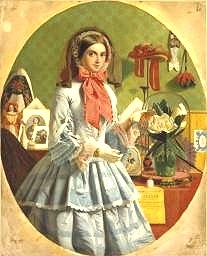
As daughters of the vicarage they would have been given their own parish duties, and probably took responsibility for shelf-stacking at their church bazaars. This young lady, painted by James Collinson in 1852, and standing by a yellow poster advertising the BAZAAR, gives you an idea.
They had close Hawkins cousins in Rivenhall, Essex, grandparents in France (until 1842) and Calland uncles, aunts and cousins in Mayfair and on the south coast, and family contacts on the Isle of Wight, and no doubt made visits and received visitors.
Brunel's Great Western Railway line from London to Bristol was completed in 1841, so trains would have been available from Swindon as soon as the family moved to Ramsbury. The nearest railway station was probably about six miles away at Hungerford. The line from Hungerford to Reading opened in 1847; from there the traveller could pick up the Bristol-London train route. I think the sisters would have visited the Great Exhibition in 1851 - they may even have stayed with Aunt Catherine in Hertford Street. Elizabeth was 34 and even the youngest, Fanny, was 12 and old enough to appreciate the displays, although their mourning (their mother died in February) might have curtailed such visits for a while.
So, to find out what they might have done during the day, I had to raid our own bookshelves for information from the 1850s-70s, when the sisters would have been old enough to notice the world, and take part if they were encouraged to do so. When Mrs Beeton published her Household Management in 1861 she was following a series of self-help books which would have informed the sisters how to manage without a lady's maid. They were probably avid readers of recipes for smelling salts, dyeing leather gloves, removing stains from clothes or wrinkles from skin, or making toothbrushes from marshmallow roots. They would have learned to strew tea-leaves on the floor to hold down the dust before brushing, to make polishing pads from old woollen stockings, to keep white clothes in a blue-lined box (to stop them yellowing) and never to dress any babies in green, because of the arsenic used to create that colour. The Ladies' Pocket Book of Etiquette published in 1838 would have made them more confident with their rich and worldly Calland cousins.
Mrs Acton's Modern Cookery for Private Families (1845) probably suited the vicarage better than Mrs Beeton because Mrs Acton taught the first principles of cooking hygiene, value for money, as well as good English recipes. Tinned and dried food was becoming available for domestic use as was silver-plated cutlery, protecting old-fashioned steel from the acids of fruit and sauces. Food was being served in separate courses instead of all being piled on the table at once, and a general air of civilisation and delicacy was replacing the older, grosser Georgian habits. Finger-bowls were placed on the table although some instruction was needed:
"Wet a corner of your napkin and wipe your mouth, then rinse your fingers; do not practise the filthy custom of gargling your mouth at table, albeit the usage prevails among the few who think because it is a foreign habit, it cannot be disgusting" [Burton].
Would the daughters have been encouraged to read a daily newspaper? The potato blight which caused the Irish famine of the 1840s [and which also affected the south of England, resulting in noisy calls for the repeal of the Corn Laws], the Crimean war of the 1850s, with that admirable Miss Nightingale, were all reported in great detail and would have engaged their interest and been the subject of conversation, although I suspect they would have been horrified when Charles Darwin published his Origin of Species. The notorious and much-reported Hill House murder happened in 1860 just outside Trowbridge in their own county! Their grandmother's exotic birth in the East India company's compound at Tamil Nadu, letters from aunts and cousins out there now, and their brother's own employment in the Bombay Staff Corps, would have heightened their interest in that area of 'overseas' at least. The Times carried advertisements aimed at the parents of the hopeful cadets and assistant surgeons who were recruited for immediate overseas postings within the Company. When Croft Augustus joined as a cadet in 1851 the family must have read carefully the advertisements from the many establishments offering
"all accoutrements and uniforms for India military service - coates with rich gold lace, blue parade frock, shell jacket, trousers, pair of rich gold epaulettes, cold shell jacket cords, gold sword knot, frock shoulder scales, shako, forage cap, town made sword, buff shoulder belt, black frog waist ditto and rich silk crimson sash supplied for £29."
And instead of shipping a heavy wooden bedstead he was strongly urged to buy a Johnson's Patent Bedstead which, for warm climates, required neither mattress nor bolster.
The Times is online now, so we can all read the theatre and opera reviews of the time (which seem always to give away the plot), and the classified columns offer 'teeth restored 2s 6d each' and '35% off Belfast damask table linen'. At 30 guineas per annum, an education for Young Ladies, teaching French, music, dancing, writing, ciphering and the use of the globes, would have been out of the question for the vicarage daughters unless someone else offered to pay. But a case of pale dinner sherry at '25s per dozen with railway carriage paid' would make an acceptable present if a parishioner asked, maybe even, at a pinch, a 'gallon of Unsophisticated Gin of highest strength at 30s railway carriage paid'. Advertisements for useful Christmas presents included silk umbrellas at 8s; horse hair socks for men, ladies and children, 'guaranteed to keep feet dry'; or 'Mrs Farey's registered head dress for young ladies available at most country milliners'. At 32s 9d a wool shawl from Peter Robinson's was a bit out of their reach, as was two guineas for 14 yards of 'silk for useful dresses' or a crinoline hoop for 17s 6d. I suspect they made their own clothes but I did not realise until writing this section that it would occupy so much of their time.
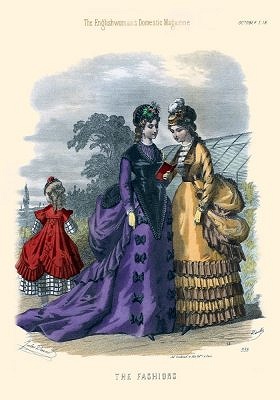
In 1850 the Ladies Newspaper told them that flounces of silk are very suitable for walking-dresses this season (it doesn't sound too difficult to add a flounce to an older dress). Later, Mrs Beeton started a new magazine for women called The Queen which was full of stories about Queen Victoria and her handsome husband, and court gossip, and everything glitzy that a rural village wanted to know all about. Mrs Beeton went to Paris for inspiration, but her flourishing career was cut short by childbirth and she died aged just 29.
In competition to The Queen and similar magazines, The Englishwoman's Domestic Magazine started publishing monthly fashion plates. This one (could it really have been printed in colour?) is from 1869. Paper dress patterns were included in many magazines to be scaled up for home dressmaking. I do not know how easy it would be for the Ramsbury sisters to get their hands or eyes on such magazines, but I am certain that they managed to do so surreptitiously, if not as breakfast reading. (My breakfast reading is New Scientist, which does not have fashion pages but, like Sarah Hawkins, I have had the same husband for over forty years so I don't think he minds much.) Dressmaking was very popular, and ladies were encouraged by all these lovely designs and free patterns in the magazines. I know about dressmaking, and can say with confidence that planning an optimum layout and cutting out a simple blouse can take three hours, so scaling up a pattern and cutting out a useful dress requiring 14 yards of silk would take easily more than a day. I also know that it takes me 45 minutes to hand-sew a yard of skirt hem. Hemming is quick; hand-sewing a yard-long seam with a firm back stitch would probably take me three times longer. Looking at the dresses here, I estimate that the basic dress structure would involve stitching about ten yards of plain seams, so that's 22 hours so far for sewing. Tacking and attaching pleats and ruffles and gathers and ribbons and lace and buttons, by hand, would probably require about the same again. So, one useful plain dress would take about 25 hours of daylight, and a fancy one at least 50 hours, and there were eight daughters.
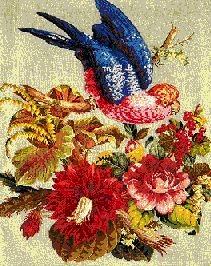
And they had to make or mend their many petticoats and bodices and nightdresses, and their outdoor cloaks and coats, and sew their father's shirts, and make curtains and cushions, and turn sheets and no doubt sew for the elderly and poor in the parish, and work on the embroidery and berlin work to be sold at those church bazaars.
Berlin work became another mid-1800s craze, when dyeing techniques improved enough to provide a wide range of colour-fast shades suitable for naturalistic embroidery, such as this very natural-looking parrot (or is it a bluebird?) The embroidery was done on hard-wearing canvas, and patterns were published in magazines so everyone made slippers and bags for everyone else, or a waistcoat for an uncle they did not much like.
If you were in a hurry, or had many relatives, berlin-work bookmarks were fast and easy to do, and could use up all your odd ends of yarn. In Stroud at around this time, admittedly with a larger population than Ramsbury, there were four shops dedicated to supplying the needs of the berlin-obsessed embroiderers of the town.
All these confident purples and reds and major key hymns illustrated the early years of Victoria's reign. The subtle colourings and minor key of the 1870s, with its pre-raphaelite art, fey poetry and aesthetic uncorseted dress, were still to come.
I am sure the vicarage daughters would have read books. By the mid-nineteenth century there were already over 250 subscription libraries in England, but the 1850 Public Libraries Act - opposed by some Conservatives because they 'might encourage the working class to challenge their betters' made reading free to all. This would have been a great boon to the cash-strapped sisters. The middle-classes did not feel the need for moral or philosophical tracts. They demanded fiction, and plenty of it. A new genre called 'silver fork' novels went into great detail about posh homes and the dress, food, furniture, conversation and manners which went on there [Burton]. A very few of the thousands of novels published then are still on our bookshelves - Jane Eyre, Adam Bede, Shirley, Sybil, Cranford, all of Dickens of course, and the merciless Anthony Trollope.
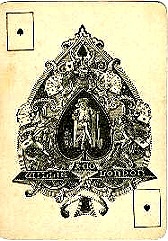
Card games were so popular that the first tax on playing cards was raised in 1588, then regularly from 1711 onwards, to generate funds for the Exchequer. The tax varied wildly, apparently depending on whether or not the country was at war, and by 1828 had reached 2s 6d - many times the cost of the actual pack of cards. It quickly dropped to one shilling (was peace in Europe the cause?) then to 3d. Even then poor working class people had to go to the pub to play cards because the landlord could afford a pack and they could not.
Mrs Gaskell writes that cribbage and preference were games much favoured by the ladies of Cranford, for whom 'cards was the most earnest and serious business they ever engaged in', and a game of whist often passed the evening after dinner. Gambling on anything was popular and brought many people to ruin - I wonder if that was one of Francis' problems? His father was certainly not prepared to trust him with any money, as you will see.
Women had very few outdoor sports, until the Queen took up archery (in a slim skirt, since a crinoline would have got tangled, and a bonnet with the brim turned up out of the way at one side).
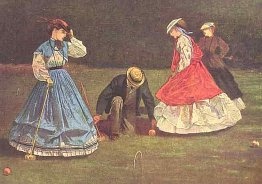
Then croquet arrived from Ireland in the 1850s. Or maybe it came from India, or from Italian peasants, but definitely not from King Charles' Pall Mall, even though the game Pell-Mell used mallets and hoops. Not even the Croquet Association is certain and since a one-time Chairman is an old friend I have an impeccable source.
If you did not happen to keep sheep, the invention of the lawnmower in 1830 (and in Stroud) enabled croquet to be carried out on any reasonably flat lawn.
Both archery and croquet would have been popular with our vicarage daughters, since the games were seemly, not too expensive to equip, not at all sweaty to play, and allowed close contact with young men, which must have been gratifying for both sexes. A diary of the time [Meynell] says
"the entertainment was croquet on summer evenings, dancing, music (which of course included singing) whist and chess".
Having a sensible young woman as Queen must have made a huge difference in households with daughters. "But papa the Queen does it" must have been a regular and, let us hope, effective plea.

